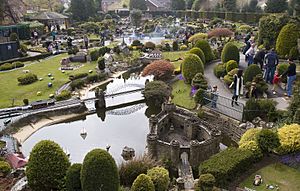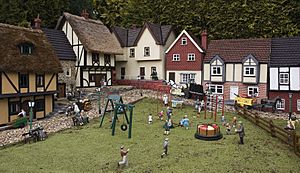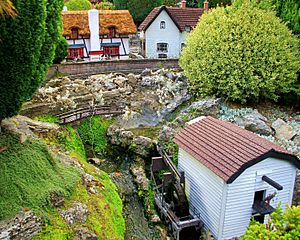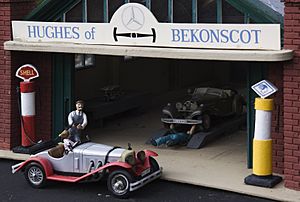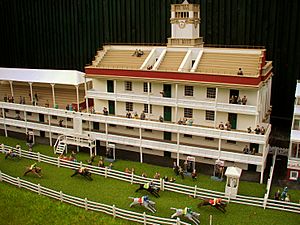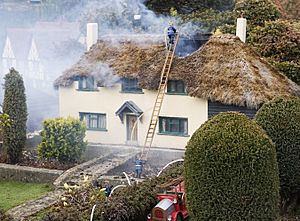Bekonscot facts for kids
Bekonscot is the world's oldest original model village. You can find it in Beaconsfield, Buckinghamshire, England. It shows what parts of England looked like, mostly in the 1930s.
Bekonscot was first built in the 1920s by Roland Callingham (1881–1961). He was an accountant who lived in Beaconsfield. Roland planned his tiny world in his large back garden. His gardener, cook, maid, and chauffeur helped him. They created a miniature English countryside. His swimming pool became the "sea," and his rockeries turned into hills. A company called Bassett-Lowke built a huge Gauge 1 model railway for the village. Roland named it Bekonscot by combining "Beaconsfield" and "Ascot", where he used to live.
Bekonscot was not meant to be a visitor attraction at first. It was just a fun project for Roland and his friends. But after 1930, many people learned about it. News channels like Pathé and newspapers shared its story. This brought many visitors. Everyone who visited was asked to give money to a railway charity.
Since 1978, the Church Army has run Bekonscot. The village gives a lot of money to charity. It has raised almost £5,000,000. More than 14,000,000 people have visited it!
Contents
The Legacy of Bekonscot
Bekonscot is famous for inspiring many other model villages around the world. Places like Madurodam and Mini-Europe were influenced by it. Because of this, Bekonscot is known as the "grandfather" of all model villages.
The village grew bigger in the first half of the 20th century. Roland Callingham sold much of the land around it. This land is now a housing estate. Today, the model village is completely surrounded by city buildings. This means it cannot get any bigger.
Bekonscot made model villages popular. It also put Beaconsfield on the map. It continues to help charities by donating money.
Exploring the Miniature Landscape
The site is about 2 acres big. More than half of it is a tiny 1:12 scale landscape. The buildings are made from natural materials, concrete, or foam board. Many of them are the original ones from the 1920s.
There are six model villages inside the miniature landscape. These towns are not real, but many buildings look like actual ones in the UK. Over the years, different model makers and gardeners have added their own touches. This means you can see many different building styles.
About 12 full-time staff work all year to keep the village looking great. During the busy season, about 20 more temporary staff help out.
You'll find funny names for shops and places. For example, there's Lee Key Plumbers' Merchants (sounds like 'leaky'). Another is Sam and Ella's Butchers (like 'salmonella'). These playful names have become a fun tradition in other model villages too.
Fun Features to See
All About the Railways
Gauge 1 Railway
Bekonscot has one of the biggest outdoor garden railways in the UK. It's a Gauge 1 railway, which means it's a specific size for model trains. It's about ten scale miles long. A computer system controls the block signalling system. This helps up to 12 trains run at the same time. There are also two old manual control panels. One is from British Railways (BR) and the other from London Underground. The BR panel is still used to manually control the trains.
Some original Bassett-Lowke trains from the 1930s are still used every day. They have new parts to keep them running. You can see different types of locomotives. These include tank engines, a 4-6-0 tender loco, and a GWR railmotor. Many of these trains are very old and important. Some have been running for over 50 years. Each one travels about 2,000 miles every year!
The model railway has changed many times since the 1920s. It doesn't copy any real railway. But two stations are based on local ones: Maryloo High Wycombe and Greenhaily Beaconsfield. There are seven stations in total. Others are inspired by Midland, Great Central, and Southern designs. You'll see tunnels, a working level crossing, and a small copy of the Sydney Harbour Bridge. A branch line crosses this bridge to the coal mine.
Over the years, staff have often thought about adding new parts to the railway. This means the railway has been changed many times.
7.25 inch Gauge Railway
A miniature railway called the Bekonscot Light Railway was built in 2001. It runs around the edge of the site and offers passenger rides. It was made longer in 2004 to a new end station. Three battery-electric trains pull the carriages. One is a Bo-Bo tram. Another is a Bo-Bo diesel shunter. The third is a large 0-4-0 built by Maxitrak. This last one was named "Sprocket" in 2004. This was the railway's third birthday and the model village's 75th birthday.
Two Foot Gauge Railway
There is also proof of a 2ft narrow gauge railway. This was used to build the village and later to move materials for upkeep. Photos from 1928 and 1932 show its route. In 2003, three complete wagon parts were found. This happened during digging for the Bekonscot Light Railway. These parts have been fixed and are now shown around Bekonscot.
Images for kids


